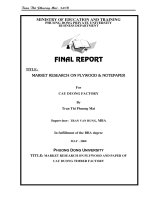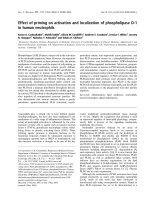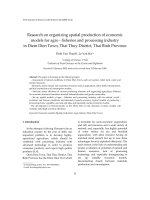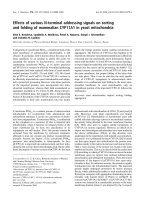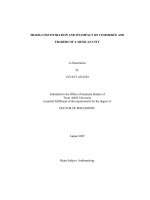Policy on planning and promotion of development of supporting industries for Vietnam
Bạn đang xem bản rút gọn của tài liệu. Xem và tải ngay bản đầy đủ của tài liệu tại đây (523.53 KB, 14 trang )
JED No.215 January 2013 | 47
Policy on Planning and Promotion of Development
of Supporting Industries for Vietnam
NGUYỄN TRỌNG HOÀI
Associate Professor, Doctor of Philosophy, UEH
email:
HUỲNH THANH ĐIỀN
Doctor of Philosophy, Corporation 28 under Ministry of National Defense
email:
ABSTRACT
This research aims at analyzing aspects determining supporting industries (SIs) to
serve the task of planning and developing such industries. Analyses show that
Vietnamese SIs are very small and unable to help the manufacturing sector increase its
added value and join the global value chain. The results find the following culprits: the
plan and policies on SI development are not compatible with main trends of market
specialization and global value chain; chain of domestic industrial production is till
lacking; and inter-industry cooperation is poor. Policy recommendations, therefore,
are as follows: establishing the exact list of SIs that help increase the added value of
local industrial production and integrate into the global value chain; and planning
space, time, track, and methods needed for carrying out such policies. Besides the
development plan, the paper also offers suggestions about policies to promote SIs,
such as legal infrastructure for SI development, design of a value chain for SIs,
building of clusters of SIs, and mechanism for promoting SI development.
Keywords: supporting industries, planning policy
48 | Nguyễn Trọng Hoài
Policy on Planning and Promotion
1. INTRODUCTION
Industrialization is a factor in the modernizing process of the production
technologies, and industrial structure from a lower to higher levels (Li, 1997; Ohno,
2006). The industrialization is considered successful when the production structure
moves from assembling or doing subcontracts (with huge volumes of imported raw
materials) to integrating actively into the global value chain with SIs developed to
reduce imported raw materials (Mori, 2005; Ohno, 2007). Vietnam is trying to
accumulate technologies to move from simple industries under guidance of foreign
companies to a highly-internalized industries that can join the global value chain, and it
therefore should make plan to develop SIs to serve its effort.
This paper aims at discussing the plan to develop SIs and policies to support their
development in Vietnam. First of all, the paper tries to build an analysis framework to
identify aspects of the SI development to analyze. Analyses of these aspects presented
in the next section may serve as a basis for the planning and policies on SI
development needed for industrialization in the coming years.
2. A FRAMEWORK FOR ANALYZING THE ROLE OF SIs
Mori (2005) defines SIs as industries that supply manufactured inputs –
intermediate goods and capital goods - to other industries. In specific conditions of a
country, however, SIs are determined by structure of existing industries, such as shares
of industries that employ inputs from SIs in total industrial production or export.
Decision 12/2011/QĐ-TTg by the Vietnamese PM on policies on SI development
defines SIs as “producers of materials, spare parts, accessories, and semi-finished
goods supplying them to industries that produce or assemble finished capital or
consumer goods.” Porter (1990) considers SIs and industrial clusters are among factors
that determine competitiveness of supported industries, while Christophe et al. (2011)
argue that development of an industry depend very much on background and trend of
international economic integration. This implies that the role of SIs varies according to
international background, or in other words, analyzing fitness of SIs requires analyses
of their compatibility with international trends.
Additionally, identifying SIs also depends on production structure of the enterprise
in specific countries. As quoted by Ohno (2006), Professor Takahiro Fujimoto of
Tokyo University has suggested two basic architectural types in manufacturing:
modular architecture and integral architecture. Their characteristics could be seen in
JED No.215 January 2013| 49
Table 1. Generally speaking, modular architecture is suitable for obtaining quick
results at low cost while integral architecture is appropriate for the pursuit of everhigher quality in the long run.
Table 1: Modular versus Integral Manufacturing
Modular manufacturing
Integral manufacturing
Parts interface
Parts are common and can be used for
any model
Each product has unique parts, specially
designed
Merits
Quick results and flexibility
Endless pursuit of quality
Demerits
No differentiation, excess entry, low
profit, lack of R&D
Much energy and time needed to
achieve results
Institutional
requirements
Openness, quick decision making,
flexible outsourcing
Long-term relations, building internal
skills & knowledge
Source: Ohno (2006), p. 15.
Manufacturing architecture of a country depends on its technological levels. Ohno
(2006) divides the industrial development of a country into four stages: stage 1, simple
manufacturing under foreign guidance; stage 2, having supporting industries, but still
under foreign guidance; stage 3, technology and management mastered, and being able
to produce high-quality goods; and stage 4, full capability in innovation and product
design as global leader. He calls the move from stage 1 to stage 2 agglomeration; stage
2 to stage 3: technical absorption; and stage 3 to stage 4: creativity. Vietnam is trying
its best to move from stage 1 to stage 2 because SI development is still in a very early
phase; only initial ideas are suggested; and the SI development plan performs poorly.
Better realization of the planning and developing SIs may produce high added values
for goods with competitive advantages, and provide good conditions for the move to
the stage of technical absorption and better integration into the regional economy.
50 | Nguyễn Trọng Hoài
Policy on Planning and Promotion
The aforementioned literature review shows that the planning of SI development
requires analyses of various aspects: background and trends of the world industrial
development; value chain of industrial production including manufacturing structure
and participation in global value chain; and linkages of existing sectors (forward and
backward linkages) and roles of industrial clusters/parks. Analytical results will serve
as a basis for development planning and recommendations to policies on SI
development by absorbing new technologies. The analytical framework is presented in
Figure 1.
Aspects to examine
Background and trends
of development of
sectors
Value chain: Structure
of industries and
products, participation in
global value chain
Industrial linkage:
domestic and
international ranges
Helping local
industries and
joining the global
value chain
Development planning:
- Identifying the list of
industries
- Location
- Schedule
- Economic sectors
- Implementing methods
Figure 1: Analytical Framework
Source: Author’s suggestion based on literature review
Encouraging
policies
- Legal
infrastructure
- Support
(technology,
capital, etc.)
- Monitoring:
Controlling,
motivating,
checking
- Policies on
linkage
JED No.215 January 2013| 51
3. AN OVERVIEW ON VIETNAMESE SIs
Vietnamese SIs have developed in recent years, but their share in industrial output
is still small, increasing from 4.37% in 2000 to 7.32% in 2008, a two-fold rise within
eight years, as shown in Table 2.
Table 2: SI Share in Industrial Output
2000
2005
2008
Total
100.00%
100.00%
100.00%
Mining industry
15.78%
11.19%
9.82%
Manufacturing industry
78.68%
83.20%
85.54%
+ SI
4.37%
6.45%
7.32%
Power, gas and water
5.54%
5.61%
4.63%
Source: GSO (2010)
The share of Vietnamese SIs in the global value chain is much smaller. Table 3
shows that in 2000-2009, the share of export from SIs did not rise, staying around
7.45% in those nine years. This implies that industrialization in Vietnam has not
entered the stage of technological agglomeration, and Vietnamese SIs are still
“separate” from the global value chain.
Table 3: SI Share in Export Value
2000
2005
2008
2009
Total export value
100%
100%
100%
100%
SI share
7.46%
7.59%
7.45%
7.45%
Electronic apparatuses and spare parts
5.45%
4.40%
4.21%
4.84%
Plastic goods
0.66%
1.10%
1.49%
1.06%
Electric wire and cable
0.89%
1.60%
1.61%
1.55%
Bicycle and spare parts
0.46%
0.49%
0.14%
0.00%
Source: GSO (2010).
52 | Nguyễn Trọng Hoài
Policy on Planning and Promotion
Table 4: Import Structure
2000
2005
2008
2009
Total
100.0
100.0
100.0
100.0
SI share
93.8
89.6
88.8
90.2
Machine, apparatus, component
30.6
25.3
28.0
29.3
Raw materials, fuel
63.2
64.4
60.9
60.9
Consumer goods
6.2
8.2
7.8
9.3
2.2
3.4
0.5
Non-monetary gold
Source: GSO (2010).
Imports used for SIs, meanwhile, still accounted for 90.2% of import value in 2009
and showed no sign of decline (Table 4). This means that the local industrial
production gained a very small added value and depended heavily on foreign markets.
4. ASPECTS IDENTIFYING SIs
a. Background and Development Trends of Sectors:
Vietnam is gradually integrating into the world economy (Võ Thanh Thu, 2010). In
this process, each country becomes a component of market and global production
chain (Đoàn Thị Hồng Vân, 2010). Changes in macroeconomic policies, technologies,
confidence, and economic crises in some countries produce great effects on politicoeconomic environment of other countries (Christophe et al., 2011). Planning of SI
development in Vietnam, therefore, requires full attention to trends of changes in
global value chain with the following characteristics:
Firstly, market for manufactured consumer goods is polarized remarkably.
Developed countries tend to consume final manufactured goods from technologyintensive industries; technological value is considered as a top priority and consumers
support eco-friendly and good-for-health products (Kunnanatt, 2011). This implies that
only a few opportunities are available for manufactured goods from developing
countries to penetrate into developed markets or get through technical barriers set by
developed countries to protect their consumers (Kunnanatt, 2011).
Secondly, most economies are interdependent: a manufactured commodity is
divided into various stages or components and produced in many countries based on
JED No.215 January 2013| 53
their comparative advantages (Cudney & Elrod, 2011). Developed countries undertake
designing and finishing the commodity (the first and last stage of production) while
developing and emerging economies produce equipments, components, and control
assembling lines (intermediate stages); these stages are assigned according to
comparative advantages of developing countries (Kunnanatt, 2011; Cudney & Elrod,
2011).
Thirdly, global sources of capital mainly come from developed economies that
manipulate production in developing countries through business strategies of
multinationals based on comparative-advantage principle to minimize production costs
(Cantarello et al., 2011). This process is supported by governments of developed
countries through official aid to infrastructure and financial development in developing
countries (Cantarello et al., 2011).
The above facts show that division of markets and production chains is taking place
at the global level based on exploiting comparative advantages of each economy. This
implies that nations should position their roles in the global market and production
chain. In other words, all nations should identify export markets for their staple
products and their positions in the global value chain. This means more difficulty for
Vietnam when its staple exports depend too much on foreign markets, its technological
absorption is poor, its SIs are scattered and the global value chain has been positioned
in developed economies.
b. Value Chain in Vietnamese Industrial Sector:
Industries considered as advantages for Vietnam are labor-intensive ones that
employ simple technologies, exploit natural resources, and attract huge foreign direct
investments (Porter et al., 2010). Its staple exports, therefore, are mainly from laborintensive and natural-resource-dependent industries (Figure 2). This is a characteristic
of a manufacturing sector with simple structure, without SIs and a driving force to
improve technological and managerial capacity of local firms (Ohno 2006; Mori 2005).
At present, Vietnam has no industry with a totally-internalized structure. Even in
industries with high export values such as clothing and footwear, internalization ratio
is still very low because imported raw materials and machinery represent huge
proportions of export value (Figure 3)
54 | Nguyễn Trọng Hoài
Policy on Planning and Promotion
Figure 2: Vietnam’s Staple Exports (US$ MN.)
Source: GSO (2010).
Figure 3: Vietnam’s Typical Imports (US$ MN.)
Source: Calculations based on GSO data (2010)
Moreover, Vietnam has not determined which one among its industries will join the
global value chain while its production under foreign guidance has a low internalizing
ability. A list of Vietnam’s staple exports (Figure 2) shows that spare parts and accessories
represent small quantities; and most of them are electronic components produced by FDI
companies and depend on foreign markets.
c. Linkages Between Industries:
Vietnamese industries are scattered in terms of value chain and space for
production. Local firms do not form a value chain for a complete industry comprising
supply of inputs, production and supply of outputs. Generally, most industries rely on
JED No.215 January 2013| 55
imported inputs, especially raw materials and spare parts (Figure 3). This is the reason
why their production cost is high and competitiveness low.
Moreover, Vietnam’s economic sectors usually operate separately, as remarked by
Porter et al. (2010, p. 95), “state enterprises concentrate on capital-intensive activities
such as transportation and utilities. Private enterprises focus on more short-term and
service-oriented activities such as retails, hotels and restaurants, real estate, etc. FDI
enterprises initially focused on import-substitution manufacturing and then gradually
shifted more to export-oriented light industries and recently to real estate.” Lack of
linkages between economic sectors prevents technology transfer and limits access to
the global value chain for local firms.
Zoning area for industrial parks and clusters is usually carried out to facilitate
control over companies instead of trying to bring similar factories together to form
some linkages between them. As Porter et al. (2010) put it, cluster development in
Vietnam has the following features: “presence of naturally emerging agglomerations;
focus on narrow industries; low level of active collaboration; economic policy tools,
e.g. industrial parks, not systematically oriented towards clusters; sector-oriented
policies largely driven by traditional industrial policy ideas; and poor implementation.”
5. POLICIES ON PLANNING AND PROMOTION OF SIs IN VIETNAM
The policy on SI development has just been given some attention recently. Decision
12/2011/QĐ-TTg issued by the PM on Feb. 24, 2011 introduced some measures to
develop Sis. The Decision offers encouragement to many SIs, including mechanical
engineering, electronics – informatics, automobile assembling and manufacturing,
clothing, footwear, and high-tech SIs. A policy encouraging participants in SI
development in terms of marketing, infrastructure, technical assistance, training,
information service and financial support has been also introduced.
Generally, SI development policy limits itself to a list of industries and fields
provided with encouragement from the government. No specific planning for the SI
development suggesting a schedule, a location and necessary measures is set forth. The
new policy, after its promulgation, is not associated with plans or projects to develop
or link SIs with industries producing finished goods, or identify SIs that can join the
global value chain.
56 | Nguyễn Trọng Hoài
Policy on Planning and Promotion
6. POLICY RECOMMENDATIONS
a. Analytical Results:
Vietnamese SIs are very small and unable to help local production enhance its
capacity, which becomes the reason why the structure of industry made no progress in
the past ten years (2000-2010). Analyses of bases for planning the SI development are
presented in Figure 4 with the following characteristics:
- Trend of internationally economic integration shows that two characteristics
relating to positioning of SIs of a nation are division of markets, and division of the
global manufacturing value chain by countries where multinationals play dominant
roles and control the global manufacturing value chain. Identifying SIs, therefore, aims
at not only supporting development of local industries but also obtaining a position in
the global value chain. This means that planning the SI development should be based
on staple products that Vietnam enjoys some comparative advantages.
- Vietnamese SIs have many limitations: Production of goods supporting local
industries requires large quantities of imported materials while export from SIs cannot
join the global value chain. This keeps Vietnamese industries at a simple
manufacturing level. Even FDI companies engage in simple manufacturing activities
or join the global value chain through their holding firms. This situation prevents local
firms from getting access to new technologies and internalizing ability cannot be
realized.
Infrastructure for development of industrial parks and clusters only facilitates state
control over industries and fails to create linkages between local firms within a cluster
or park.
SI development policy limits itself to a list of industries and fields encouraged by
the government and fails to suggest a schedule, a location and implementing measures.
Such policies are not associated with plans or projects to develop or link SIs with
industries producing finished goods, or fail to identify SIs that can join the global value
chain.
b. Policy Recommendations:
The SI development plan should pay attention to groups of SIs requiring support,
participants in each group, locations for building factories, schedule of SI
development, and implementing methods.
JED No.215 January 2013| 57
– Planning for each SI and participants:
Planning at industry level should be based on SI importance to domestic production
and its position in global value chain. Regarding participation in the global value
chain, selected SIs should be the ones that produce goods easily integrated into various
products. In other words, they are modular manufacturing industries. In Vietnam, such
industries should be automobile parts, electronics and mechanical engineering.
Participants in these industries for the time being are FDI companies. This implies that
government support in terms of training, financial services, and market development is
not necessary, except for a better investment climate.
Analyses of manufacturing structure of local firms show that most of them made
final goods that are simple, based on imported raw materials and of low added values.
The most typical are clothing and footwear industries, and therefore, SIs for such
industries should be developed as soon as possible. Participants in these SIs are
certainly local firms who are badly in need of government support in various aspects as
mentioned by Decision 12/2011/QĐ-TTg. Main market for such SIs is the domestic
one while foreign ones should have lower priority.
Development of SIs for high-tech industries requires careful plans because they are
integral manufacturing industries. Because these SIs depend very much on foreign
designing and completing factories, participants in these SIs are FDI companies, at
least in a short run. In a longer term, new technologies may be transferred to local
firms.
- Location for SI development:
SIs that join the global value chain or have an integral manufacturing structure tend
to pay more attention to infrastructure conditions and supply of labor than
organizational issues because their products are sold to foreign companies and their
markets have been determined.
As for SIs for assemblers or producers of final goods for domestic market, the plan
should identify locations for factories in vertical or horizontal linkages, including
producers of raw materials and parts and components, to assemblers of finished goods.
These locations may become industrial clusters or parks.
– Schedule and implementing methods:
58 | Nguyễn Trọng Hoài
Policy on Planning and Promotion
The SI development plan should determine a short-term plan for local firms that
want to build SIs for domestic production of final goods, along with a long-term one to
attract FDI companies that are able to join the global value chain. In this process,
cooperation between local and FDI companies should be built to facilitate transfer of
technology and social capital in order to help local firms take part in the global value
chain.
c. On Policies Encouraging SI Development:
To help SIs development and serve as a driving force for domestic industries, and
find a foothold in the global value chain, the government should adopt various
encouraging policies:
- Building a legal infrastructure for SI development by introducing an SI
development master plan that serves as a basis for similar plans at provincial/municipal
level: Provinces in the same economic zone can cooperate in developing their SIs. A
National SI Commission can be formed to monitor the whole process, give advices
about SI planning and policies to both central and local governments.
- Examining designs of manufacturing chain in certain industries to identify
supporting stages in the chain: In Vietnam up until now, making such designs have
been done totally by companies. It is about time the government assumed the
responsibility in some key industries to determine which stages belong to SI and
include them in the SI development plan.
- Carrying out a pilot project to build an SI cluster in a province where
manufacturing sector develops well: The selected province may be in Eastern South
Vietnam that enjoys the highest economic growth rate. To ensure success for the pilot
project, several well-managed state-owned companies can be allowed to play leading
roles. Target industries may be clothing or footwear ones because they produce staple
exports.
- Introducing a mechanism for promoting SI development: This support should
comprise improved infrastructure, technical and financial assistance, and establishment
of close linkages in the value chain. The mechanism can be realized through various
programs and projects that aim at attracting more companies to SIs.
JED No.215 January 2013| 59
7. CONCLUSION
SIs play an important role in generating added values for manufactured products.
An SI development plan should be based on analyses of international background,
manufacturing value chain and linkages between domestic and foreign industries. Such
a plan should identify a list of SIs and their future positions in the global value chain;
along with locations, schedules and methods of implementing the plan. In addition to
the plan, various policies should be adopted to encourage the SI development,
including policies to improve legal system, make designs of value chains for key
industries, carry out a pilot project to build an SI cluster, and establish a mechanism for
promoting SI development
References
Campaniaris, C. et al. (2011), "The Applicability of Cluster Theory to Canada's Small and MediumSized Apparel Companies", Journal of Fashion Marketing and Management, Vol. 15 Iss: 1, pp.8
– 26.
Cantarello, S. et al. (2011), "External Technology Sourcing: Evidence from Design-driven
Innovation", Management Decision, Vol. 49 Iss: 6, pp.962 – 983.
Christophe, M. et al. (2011), "Approaches to Managing Global Sourcing Risk", Supply Chain
Management: An International Journal, Vol. 16 Iss: 2, pp.67 – 81.
Cudney, E. & C. Elrod (2011), "A Comparative Analysis of Integrating Lean Concepts into Supply
Chain Management in Manufacturing and Service Industries", International Journal of Lean Six
Sigma, Vol. 2 Iss: 1, pp.5 – 22.
Đoàn Thị Hồng Vân (2010), “Một số giải pháp tái cấu trúc thị trường xuất nhập khẩu” in Kỉ yếu hội
thảo khoa học: Phục hồi, thúc đẩy tăng trưởng và kiểm soát lạm phát sau suy giảm kinh tế tại
VN (Proceedings of Seminar “Promoting Economic Growth and Controlling Inflation after a
Period of Recession in Vietnam”) held by University of Economics HCMC, pp. 165-175.
Kunnanatt, J.T. (2011), "Global Business Chain and Twin Advantage: Strategic Opportunities for
Developing Countries", Competitiveness Review: An International Business Journal
Incorporating, Journal of Global Competitiveness, Vol. 21 Iss: 4, pp.352 – 368.
Li, L. & G. Vinten (1997), "An Overview of the Experiences of Chinese Industrialization Strategies
and Development", Managerial Auditing Journal, Vol. 12 Iss: 4/5, pp.183 – 191.
Marktanner, M., & J. Nasr (2009), "Potentials of Democratization, Demilitarization,
Industrialization, and Contraception", Journal of Economic Studies, Vol. 36 Iss: 3, pp.236 – 249.
60 | Nguyễn Trọng Hoài
Policy on Planning and Promotion
Mori, J. (2005), Development of Supporting Industries for Vietnam’s Industrialization: Increasing
Positive Vertical Externalities Through Collaborative Training, Master of Arts in Law and
Diplomacy Thesis, The Fletcher School.
Ohno K., (2006), Hoạch định chính sách công nghiệp ở Thái Lan, Malaysia và Nhật: Bài học kinh
nghiệm cho các nhà hoạch định chính sách VN, (translation of Industrial Policy Formulation in
Thailand, Malaysia and Japan: Lessons for Vietnamese Policy Makers), Lao động xã hội
Publisher, Hà Nội.
Ohno, K., (2007), “Building Supporting Industries in Vietnam”, Vietnam Development Forum
(VDF), Vol 1.
Porter, M.E, & Vietnam’s Central Institute for Economic Management (2010), Báo cáo đánh giá
năng lực cạnh tranh của quốc gia của VN (Vietnamese version of Vietnam Competitiveness
Report 2010 by Michael E. Porter), Hà Nội.
Porter, M.E., (1990), The Competitive Advantage of Nations, Free Press, New York.
GSO (2010), Niên giám thống kê VN (Vietnam’s Statistical Yearbook) retrieved from
on Aug. 8, 2011.
Võ Thanh Thu (2010), “Bàn về giải pháp giảm nhập siêu ở VN hiện nay”, in Kỉ yếu hội thảo khoa
học: Phục hồi, thúc đẩy tăng trưởng và kiểm soát lạm phát sau suy giảm kinh tế tại VN
(Proceedings of seminar “Promoting Economic Growth and Controlling Inflation after a Period
of Recession in Vietnam”) held by University of Economics HCMC, pp.155-164.

